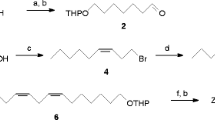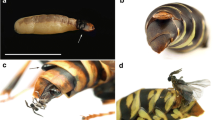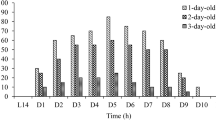Abstract
(Z, Z)-6,9-Heneicosadien-11-one (Z6Z9-11-one-21Hy) was identified as the major sex pheromone component of the painted apple moth (PAM), Teia anartoides (Lepidoptera: Lymantriidae), on the basis of (1) comparative gas chromatographic-electroantennographic detection (GC-EAD) analyses, GC-mass spectrometry (MS), high-performance liquid chromatography (HPLC)-MS, and HPLC-UV/visible spectroscopy of pheromone gland extracts and authentic standards; (2) GC-EAD analyses of effluvia of calling females; and (3) wind tunnel and field trapping experiments with a synthetic standard. In field experiments in Australia, synthetic Z6Z9-11-one-21Hy as a single component attracted male moths. Wind tunnel experiments suggested that a 4-component blend consisting of Z6Z9-11-one-21Hy, (6Z,9R,10S)-cis-9,10-epoxy-heneicosene (Z6-9R10S-epo-21Hy), (E, E)-7,9-heneicosadien-6,11-dione (E7E9-6,11-dione-21Hy), and 6-hydroxy-(E, E)-7,9-heneicosadien-11-one (E7E9-6-ol-11-one-21Hy) (all present in pheromone gland extracts) might induce more males to orient toward, approach, and contact the source than did Z6Z9-11-one-21Hy as a single component. Additional experiments are needed to determine conclusively whether or not Z6-9R10S-epo-21Hy, E7E9-6,11-dione-21Hy, and E7E9-6-ol-11-one-21Hy might be minor sex pheromone components of PAM. Moreover, attractiveness of synthetic pheromone and virgin PAM females needs to be compared to determine whether synthetic pheromone could replace PAM females as trap baits in the program to monitor eradication of exotic PAM in New Zealand.
Similar content being viewed by others
References
ARN, H., STäDLER, E., and RAUSCHER, S. 1975. The electroantennographic detector–a selective and sensitive tool in the gas chromatographic analysis of insect pheromones. Z. Naturforsch. 30c:722–725.
BLACK, G. P., MURPHY, P. J., NIGEL, D. A., HIBBS, D. E., HURSTHOUSE, M. B., and MALIK, K. M. A. 1996. A short synthetic route to the tricyclic guanidinium core of the batzelladine alkaloids. Tetrahedron Lett. 37:6943–6946.
BROWN, A. L. and AHUJA, V. K. 1973. “P-2 nickel” catalyst with ethylenediamine, a novel system for highly stereospecific reduction of alkynes to cis-olefines. J. Chem. Soc. Chem. Comm. 553–554.
BELL, R. A., OWENS, C. D., SHAPIRO, M., and TARDIF, J. R. 1981. Development of mass-rearing technology, pp. 599–633, in C. C. Doane and M. L. McManus (eds.). The Gypsy Moth: Research Toward Integrated Pest Management. U.S. Dept. Agric., Forest Service, Tech Bull. 1584, 747 pp.
COMMON, I. F. B. 1990. Moths of Australia. E. J. Brill, Leiden, 535 pp.
EDWARDS, E. D. 1996. Lymantriidae, in E. S. Nielsen, E. D. Edwards and T. V. Rangsi (eds.). Checklist of the Lepidoptera of Australia. Monograph on Australian Lepidoptera, Vol. 4, 529 pp.
GRAY, T. G., SLESSOR, K. N., SHEPHERD, R. F., GRANT, G. G., and MANVILLE, J. F. 1984. European pine shoot moth, Rhyacionia buoliana (Lepidoptera: Tortricidae): Identification of additional pheromone components resulting in an improved lure. Can. Entomol. 116:1525–1532.
GRANT, G. G., SLESSOR, K. N., LIU, W., and ABOU-ZAID, M. M. 2003. (Z, Z)-6,9-Heneicosadien-11-one: Labile sex pheromone of the whitemarked tussock moth, Orgyia leucostigma. J. Chem. Ecol. 29:589–601.
GRIES, G., SLESSOR, K. N., GRIES, R., KHASKIN, G., WIMALARATNE, P. D. C., GRAY, T. G., GRANT, G. G., TRACEY, A. S., and HULME, M. 1997. (Z)-6,(E)-8-Heneicosadien-11-one: Synergistic sex pheromone component of Douglas-fir tussock moth, Orgyia pseudotsugata (McDunnough) (Lepidoptera: Lymantriidae). J. Chem. Ecol. 23:19–34.
GRIES, R., KHASKIN, G., GRIES, G., BENNETT, R. G., KING, G. G. S., MOREWOOD, P., SLESSOR, K. N., and MOREWOOD, W. D. 2002. (Z, Z)-4,7-Tridecadien-(S)-2-yl acetate: sex pheromone of Douglas-fir cone gall midge, Contarinia oregonensis. J. Chem. Ecol. 28:2283–2297.
GRIES, R., KHASKIN, G., KHASKIN, E., FOLTZ, J. L., SCHAEFER, P. W., and GRIES, G. 2003. Enantiomers of (Z, Z)-6,9-heneicosadien-11-ol: Sex pheromone components of Orgyia detrita. J. Chem. Ecol. 29:2201–2212.
HAYASHI, T. 1990. Allyl dithiocarbamate as a new β-acyl vinyl anion equivalent. Tetrahedron Lett. 31:4155–4158.
JURY, J. C., FIELDER, S., and VIGNESWARAN, M. 2003. Synthesis of 6Z,8E-heneicosadien-11-one, a sex pheromone of the painted apple moth, Teia anartoides. Tetrahedron Lett. 44:27–28.
K’NIG, W. A., GEHRCKE, B., ICHELN, D., EVERS, P., D’NNECKE, J., and WANG, W. 1992. New selectively substituted cyclodextrins as stationary phases for the analysis of chiral constituents of essential oils. J. High. Resol. Chromatogr. 15:367–372.
LIU, W. 1999. Semiochemistry of Orgyia and Diatraea lepidopteran species and affinity labelling of 2,3-oxidosqualene cyclase. Ph.D. Thesis, Department of Chemistry, Simon Fraser University.
MALINOVSKII, M. S. 1965. Epoxides and their derivatives. Israel Program for Scientific Translations, Ltd. Sivan Press. Jerusalem.
MILLER, J. R. and ROELOFS, W. L. 1978. Sustained flight tunnel for measuring insect responses to wind-borne sex pheromones. J. Chem. Ecol. 4:187–198.
MARSHALL, J. A. and ZOU, D. 2000. A new synthesis of 3-carboxy-2,5-disubstituted furans and their conversion to 5-vinyl derivatives. Tetrahedron Lett. 41:1347–1350.
MUTO, S. E. and MORI, K. 2003. Synthesis of the four components of the female sex pheromone of the painted apple moth, Teia anartoides. Biosci. Biotech. Biochem. 67:1559–1567.
PIETRUSZKA, J., HOCHMUT, D. H., GEHRCKE, B., ICHELN, D., RUNGE, T., and K’NIG, W. A. 1992. Gas chromatographic enantioseparation of allenes. Tetrahedr. Asymm. 3:661–670.
RIDLEY, G. 1999 Painted apple moth update. Forest Research, Forest Health News No. 90, October 1999.
TAYLOR, J. D. and WOLF, J. F. 1972. Lithiotriphenylphosphinoacetonide, a new type of 1,3-dianion. J. Chem. Soc. Chem. Comm. 876–877.
SAS/STAT. 1988. User’s Guide, Release 6.03 edition, SAS Institute, Cary, NC.
STILL, W. C., KAHN, M., and MITRA, A. 1978. Rapid chromatographic technique for preparative separation with moderate resolution. J. Org. Chem. 43:2923–2925.
SUCKLING, D. M., CHARLES, J. G., ALLEN, D., and STEVENS, P. S. 2002. Possibility of control of painted apple moth (Teia anartoides) using single component mating disruption. New Zealand Plant Protection 55:1–6.
VAN DEN DOOL, H. and KRATZ, P. D. 1963. A generalization of the retention index system including linear temperature programmed gas-liquid partition chromatography. J. Chromatogr. 2:463–471.
WIMALARATNE, P. D. C. 1998. Identification and synthesis of moth pheromones. Ph.D. Thesis, Department of Chemistry, Simon Fraser University.
ZAR, J. H. 1984. Biostatistical Analysis. Prentice-Hall, Englewood Cliffs, N.J.
Author information
Authors and Affiliations
Corresponding author
Rights and permissions
About this article
Cite this article
Gries, R., Khaskin, G., Clearwater, J. et al. (Z, Z)-6,9-Heneicosadien-11-One: Major Sex Pheromone Component Of Painted Apple Moth, Teia anartoides. J Chem Ecol 31, 603–620 (2005). https://doi.org/10.1007/s10886-005-2048-z
Received:
Accepted:
Issue Date:
DOI: https://doi.org/10.1007/s10886-005-2048-z




